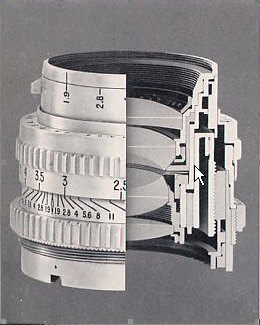| |
diaphragm controls.
The precision of the mounts insures optimum performance of the functions
far which each Ektar lens was designed.
Interchangeability
and operation I
The design of the lens mounts is such
as to permit quick precise interchangeability and positive coupling with
the range-finder system. A red dot at the top of the lens-seat sleeve,
and a wide key slot at the bottom, serve as quick guides to accurate positioning
on the camera. When one of the lenses is fully screwed into place, an
automatic lock grips it and holds it immovable. It can then be unscrewed
only by first disengaging the lock plunger. Once in position, the lens
automatically interlocks with the driving member of the range finder mechanism
for critical automatic focusing. A large, milled ring on the mount facilitates
rapid preliminary focusing, and the final precise adjustment is made by
means of the small focusing knob. Located on the front of the camera,
and convenient to the left hand, this knob permits using the same finger
movements in focusing any of the lenses except those of the greatest focal
lengths.
The f/3.5 35-mm., f/3.5
50-mm., and f/1.9 35-mm. have two-phase focusing scales--a de luxe
feature found elsewhere only on the accessory lenses for 16-mm. Ciné-Kodaks.
Normal focusing extends from infinity to 3 1/2 feet.
But
drawing out a latch at the side of the mount releases the focusing sleeve
for movement beyond the limit of the normal scale, and into a secondary
scale engraved in red. This scale extends the ranges to distances short
as one foot. The range finder does not operate at short distances, but
correct focus can be rapidly and accurately determined by measurement
from a red focal-plane index mark atop the camera, or with the aid of
the accessory ground-glass back. The 135-mm. lens focuses down to 4 feet,
the 153mm.. lens to 5 feet.
|
|
| |

|
|
All
lens barrels carry the usual diaphragm scale, and also a depth-of-field
scale. This latter adjoins the distance markings, and when the camera
has been focused the depth of the field at the selected diaphragm opening
is immediately apparent to left and right of the distance index mark.
Near this mark is a small red dot. Positioned to take into account the
plane in which infrared rays come to a focus, it is used instead of the
regular index mark when making pictures on infrared film. All of the scales
and the infrared index as well, are visible from above the camera, so
that any of them can be seen at a glance.
|
|
